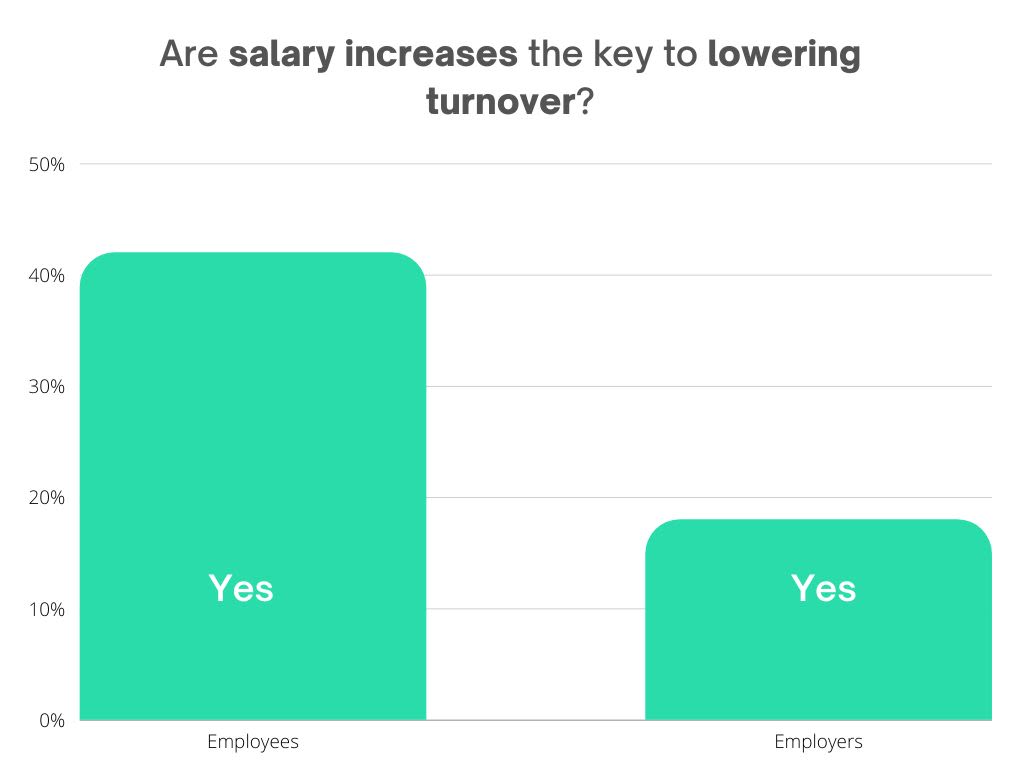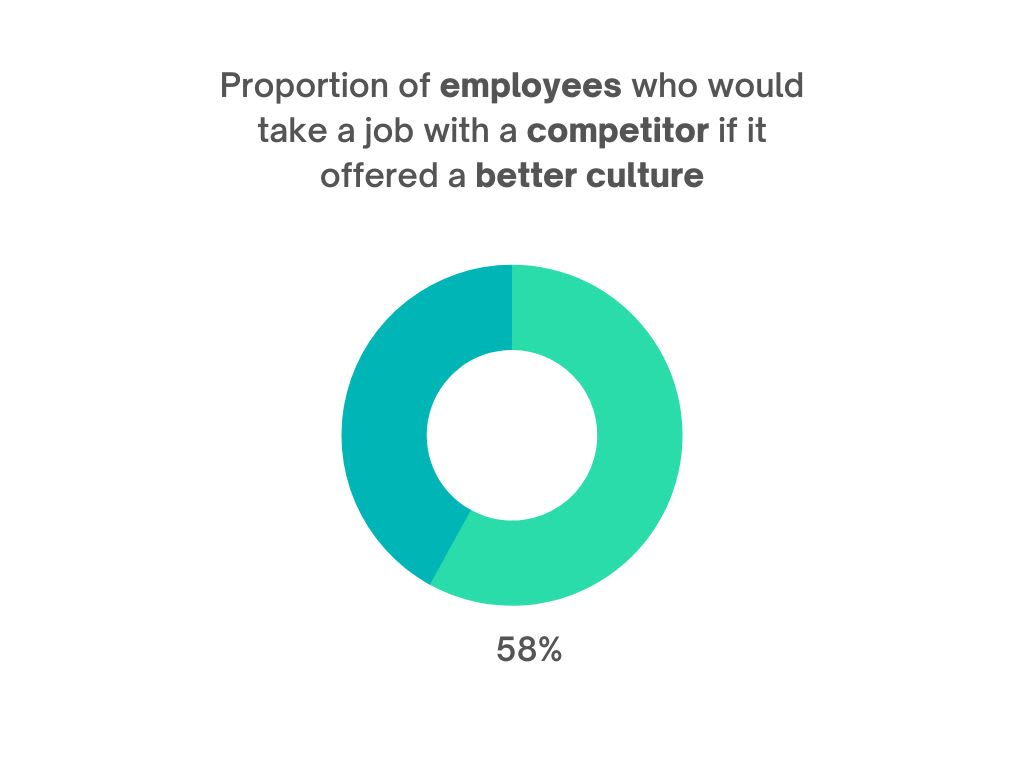
Employee Retention Statistics: Causes, Costs and Strategies
November 01, 2022

As the world continues to undergo profound change, there are many pressing challenges bearing down on business owners. Retaining talented workers is one such talent.
The Great Resignation, also known as the turnover crisis, has seen a record-breaking number of employees quit their jobs since the start of 2021, and it shows little sign of slowing down. A report by Microsoft found 52% of millennials and Gen Z are likely to consider changing their employer this year alone.
To avoid the substantial costs associated with high turnover, organizations need to address the issues prompting resignations en masse and improve their retention rates.
The most common reasons employees leave
We've pulled together research and statistics on employee retention and the main reasons people choose to leave their jobs. Here are our key findings:
- Record inflation and the cost of living crisis mean more employees are seeking higher salaries or better rates of pay.
- The current skills shortage is leading to unmanageable workloads for those in employment.
- Workers are increasingly attracted by employee benefits and are willing to take new employment for a better package.
- The working environment plays a crucial role in retention, with over half of employees saying a better company culture could steal them away from their current employer.
- Ongoing training and development are necessary for employee retention, with continued learning a priority for Gen Z.
Salary
With the cost of living at an all time high and record levels of inflation, many employees are seeking alternative employment simply because they want better pay.
The EY 2022 Work Reimagined Survey found that the main motivation for more than a third of workers actively looking for a new job was a salary increase.
However, there seems to be a difference of opinion over the importance of pay to employee retention. In the same EY survey, 42% of the employees interviewed saw salary increases as key to lowering turnover, but only 18% of employers agreed.
Workload
The UK may be seeing low levels of unemployment, but it's also experiencing a major skills shortage. Digital skills are of particular note, with 55% of workers claiming their organization lacks the necessary tech talent.
What this leads to is more work put on the shoulders of talent that does exist, often to an excessive degree, with 38% of employees reporting unmanageable workloads.
Feeling put on is often enough for an employee to look elsewhere, but it has a more dangerous consequence. Research pinpoints excessive workload as the number one cause of work related stress - a major contributor to burnout, which in turn ranked as the number one reason employees quit in 2021.
Benefits
Today's workers do not base the value of their job on salary alone. They consider the entire package, including the benefits they receive. Even more so in a post-pandemic world, with employee benefits such as mental health initiatives, flexible working and financial planning support in high demand.
Whilst research by Mercer shows 73% of large organizations are spending more on benefits per employee than they were prior to COVID-19, the numbers are not so positive when it comes to SMEs. Stats from Salesforce indicate just 19% of growing SMEs invested more in employee benefits as a result of the pandemic, with 58% making no changes at all.
The employee perspective is clear though. Of those currently looking to quit their job, 35% are searching for better benefits and 24% a better work-life balance.
Company culture
Company culture is another key factor for the generations that make up today's workforce. Whilst the ideal culture is hard to define, signs of a bad work environment are many and include a lack of communication, employee conflict and of course, low retention rates.
Stats show that almost one in three people have left a job owing to workplace conflict, whilst 58% of employees say they would take a job with a competitor organization if it offered a better culture.
Lack of opportunity
In a recent study by Mckinsey and Co., a lack of career development was given as the primary reason for quitting a job by 41% of respondents. It's a growing trend, with more and more workers feeling they need to switch their employer to advance their career.
It's not so much about the prospect of promotion as it is about ongoing training opportunities. LinkedIn's 2021 Workplace Learning Report found that 76% of Gen Z employees see continued learning as key to a successful career.
The cost of losing an employee
The true expense of low retention rates is often overlooked, but when an employee chooses to quit their job it comes at a considerable cost to the employer. The factors that need to be taken into consideration here include:
- Recruitment - the costs directly associated with replacing the employee.
- Onboarding - the financial outlay for new employee training and associated hours required from HR and management.
- Loss of productivity - the indirect costs that result from a new employee needing time to reach the same level of productivity as their predecessor.
- Increased errors - another indirect cost, mistakes typically occur as a new employee learns the ropes.
- Lost relationships - in customer-focused roles the departure of an employee can result in lower levels of customer service or a breakdown in working relationships.
Taking all of this into account, it is estimated that the average cost of replacing an employee is somewhere between six to nine months of their salary.
How are businesses improving employee retention?
As we've seen, the search for a higher paycheck is one of the main reasons employees choose to quit their jobs. In response to this, 62% of FTSE 350 companies in the UK plan to implement salary increases of between 2% and 4% in their next pay reviews, with similar figures reported from the US.
Of course, this may not be a viable retention strategy for smaller businesses and start-ups, so alternative solutions must be found.
Focus on effective onboarding - the onboarding process is a crucial part of the candidate journey. It is where a new hire becomes immersed in company culture and an integral part of a team, as well as an opportunity to bring them up to speed, equip them with the necessary resources and minimize any loss of productivity.
Organizations with an effective onboarding process improve new hire retention by 82%.
Revisit employee benefits - when it comes to employee benefits it's not all about those that have financial value, although these are a priority for today's employees. Along with physical and mental health programs consider providing financial planning support and the flexible working arrangements that promote a healthy work-life balance.
Praising hard work goes a long way too. 79% of millennial and Gen Z workers say they would be more loyal to their employer in return for recognition rewards.
Invest in learning - there are various ways to provide ongoing learning opportunities to employees, some of which require little financial investment. LinkedIn Learning became popular with Gen Z during the pandemic, with the number of those using the platform increasing by two and a half times in 2020 compared to 2019.
However you invest in training it comes with a high return. Employees that are given access to professional development opportunities have a 34% higher retention rate than those that aren't.
Boost your hiring power.
Start using Neuroworx today.
Talk is cheap. We offer a 14-day free trial so you can see our platform for yourselves.
Try for free




